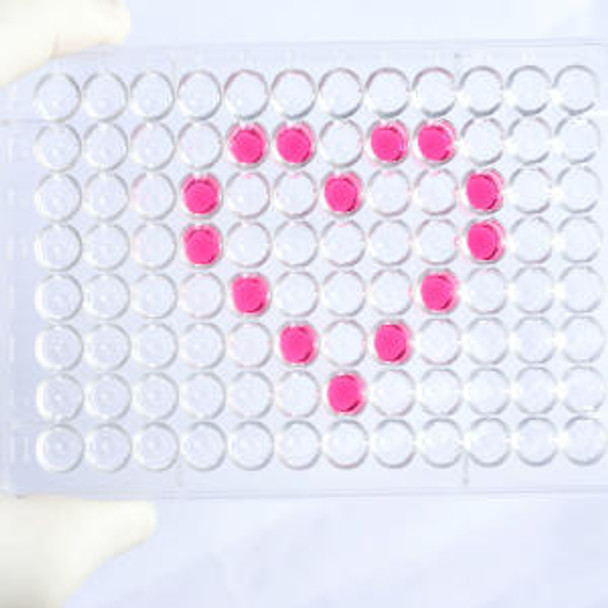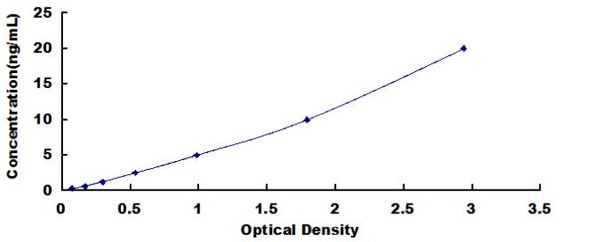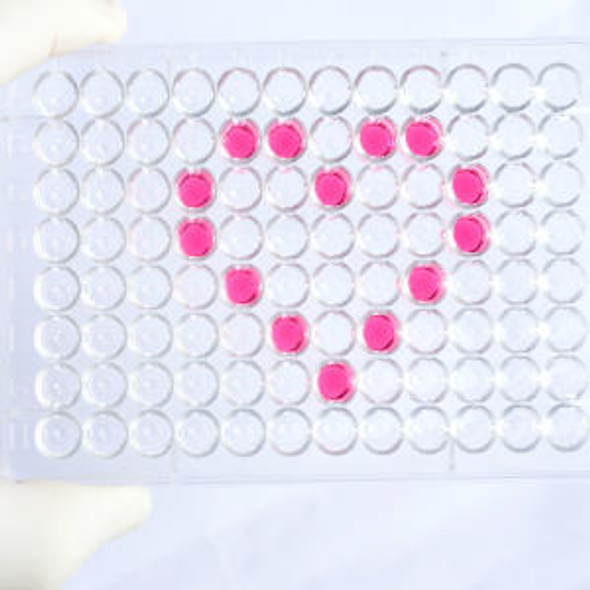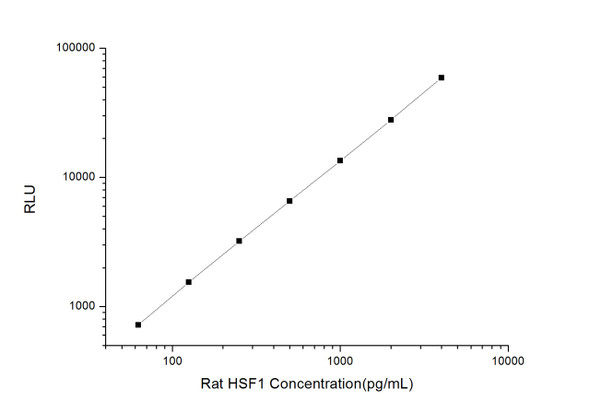Human Heat shock factor protein 1 (HSF1) ELISA Kit (HUEB0666)
- SKU:
- HUEB0666
- Product Type:
- ELISA Kit
- Size:
- 96 Assays
- Uniprot:
- Q00613
- Range:
- 0.312-20 ng/mL
- ELISA Type:
- Sandwich
- Synonyms:
- HSF1, HSTF1, heat shock factor protein 1, heat shock transcription factor 1HSTF1HSF 1
- Reactivity:
- Human
Description
| Product Name: | Human Heat shock factor protein 1 (HSF1) ELISA Kit |
| SKU: | HUEB0666 |
| Size: | 96T |
| Target: | Human Heat shock factor protein 1 (HSF1) |
| Synonyms: | Heat shock transcription factor 1, HSTF 1, HSF 1, HSTF1 |
| Assay Type: | Sandwich |
| Detection Method: | ELISA |
| Reactivity: | Human |
| Detection Range: | 0.312-20ng/mL |
| Sensitivity: | 0.11ng/mL |
| Intra CV: | 3.5% | ||||||||||||||||||||
| Inter CV: | 7.2% | ||||||||||||||||||||
| Linearity: |
| ||||||||||||||||||||
| Recovery: |
| ||||||||||||||||||||
| Function: | (Microbial infection) Plays a role in latent human immunodeficiency virus (HIV-1) transcriptional reactivation. Binds to the HIV-1 long terminal repeat promoter (LTR) to reactivate viral transcription by recruiting cellular transcriptional elongation factors, such as CDK9, CCNT1 and EP300. |
| Uniprot: | Q00613 |
| Sample Type: | Serum, plasma, tissue homogenates, cell culture supernates and other biological fluids |
| Specificity: | Natural and recombinant human Heat shock factor protein 1 |
| Sub Unit: | Monomer; cytoplasmic latent and transcriptionally inactive monomeric form in unstressed cells (PubMed:8455624, PubMed:7935376, PubMed:7935471, PubMed:7623826, PubMed:9222587, PubMed:9727490, PubMed:11583998). Homotrimer; in response to stress, such as heat shock, homotrimerizes and translocates into the nucleus, binds to heat shock element (HSE) sequences in promoter of heat shock protein (HSP) genes and acquires transcriptional ability (PubMed:8455624, PubMed:7935471, PubMed:7623826, PubMed:9222587, PubMed:9727490, PubMed:11583998, PubMed:26754925). Interacts (via monomeric form) with FKBP4; this interaction occurs in unstressed cells (PubMed:11583998). Associates (via monomeric form) with HSP90 proteins in a multichaperone complex in unnstressed cell; this association maintains HSF1 in a non-DNA-binding and transcriptional inactive form by preventing HSF1 homotrimerization (PubMed:9727490, PubMed:11583998, PubMed:15661742, PubMed:16278218). Homotrimeric transactivation activity is modulated by protein-protein interactions and post-translational modifications (PubMed:11583998, PubMed:15016915, PubMed:16554823, PubMed:26754925). Interacts with HSP90AA1; this interaction is decreased in a IER5-dependent manner, promoting HSF1 accumulation in the nucleus, homotrimerization and DNA-binding activities (PubMed:26754925). Part (via regulatory domain in the homotrimeric form) of a large heat shock-induced HSP90-dependent multichaperone complex at least composed of FKBP4, FKBP5, HSP90 proteins, PPID, PPP5C and PTGES3; this association maintains the HSF1 homotrimeric DNA-bound form in a transcriptionally inactive form (PubMed:9727490, PubMed:11583998, PubMed:16278218). Interacts with BAG3 (via BAG domain); this interaction occurs in normal and heat-shocked cells promoting nuclear shuttling of HSF1 in a BAG3-dependent manner (PubMed:26159920). Interacts (via homotrimeric and hyperphosphorylated form) with FKBP4; this interaction occurs upon heat shock in a HSP90-dependent multichaperone complex (PubMed:11583998). Interacts (via homotrimeric form preferentially) with EEF1A proteins (PubMed:15016915). In heat shocked cells, stress-denatured proteins compete with HSF1 homotrimeric DNA-bound form for association of the HSP90-dependent multichaperone complex, and hence alleviating repression of HSF1-mediated transcriptional activity (PubMed:11583998). Interacts (via homotrimeric form preferentially) with DAXX; this interaction relieves homotrimeric HSF1 from repression of its transcriptional activity by HSP90-dependent multichaperone complex upon heat shock (PubMed:15016915). Interacts (via D domain and preferentially with hyperphosphorylated form) with JNK1; this interaction occurs under both normal growth conditions and immediately upon heat shock (PubMed:10747973). Interacts (via D domain and preferentially with hyperphosphorylated form) with MAPK3; this interaction occurs upon heat shock (PubMed:10747973). Interacts with IER5 (via central region); this interaction promotes PPP2CA-induced dephosphorylation on Ser-121, Ser-307, Ser-314, Thr-323 and Thr-367 and HSF1 transactivation activity (PubMed:25816751, PubMed:26496226, PubMed:26754925). Found in a ribonucleoprotein complex composed of the HSF1 homotrimeric form, translation elongation factor eEF1A proteins and non-coding RNA heat shock RNA-1 (HSR1); this complex occurs upon heat shock and stimulates HSF1 DNA-binding activity (PubMed:16554823). Interacts (via transactivation domain) with HSPA1A/HSP70 and DNAJB1; these interactions result in the inhibition of heat shock- and HSF1-induced transcriptional activity during the attenuation and recovery phase from heat shock (PubMed:7935376, PubMed:9222587, PubMed:9499401). Interacts (via Ser-303 and Ser-307 phosphorylated form) with YWHAE; this interaction promotes HSF1 sequestration in the cytoplasm in an ERK-dependent manner (PubMed:12917326). Found in a complex with IER5 and PPP2CA (PubMed:26754925). Interacts with TPR; this interaction increases upon heat shock and stimulates export of HSP70 mRNA (PubMed:17897941). Interacts with SYMPK (via N-terminus) and CSTF2; these interactions occur upon heat shock (PubMed:14707147). Interacts (via transactivation domain) with HSPA8 (PubMed:9499401). Interacts with EEF1D; this interaction occurs at heat shock promoter element (HSE) sequences (PubMed:21597468). Interacts with MAPKAPK2 (PubMed:16278218). Interacts with PRKACA/PKA (PubMed:21085490). Interacts (via transactivation domain) with GTF2A2 (PubMed:11005381). Interacts (via transactivation domain) with GTF2B (PubMed:11005381). Interacts (via transactivation domain) with TBP (PubMed:11005381). Interacts with CDK9, CCNT1 and EP300 (PubMed:27189267). Interacts (via N-terminus) with XRCC5 (via N-terminus) and XRCC6 (via N-terminus); these interactions are direct and prevent XRCC5/XRCC6 heterodimeric binding and non-homologous end joining (NHEJ) repair activities induced by ionizing radiation (IR) (PubMed:26359349). Interacts with PLK1; this interaction occurs during the early mitotic period, increases upon heat shock but does not modulate neither HSF1 homotrimerization and DNA-binding activities (PubMed:15661742, PubMed:18794143). Interacts (via Ser-216 phosphorylated form) with CDC20; this interaction occurs in mitosis in a MAD2L1-dependent manner and prevents PLK1-stimulated degradation of HSF1 by blocking the recruitment of the SCF(BTRC) ubiquitin ligase complex (PubMed:18794143). Interacts with MAD2L1; this interaction occurs in mitosis (PubMed:18794143). Interacts with BTRC; this interaction occurs during mitosis, induces its ubiquitin-dependent degradation following stimulus-dependent phosphorylation at Ser-216, a process inhibited by CDC20 (PubMed:18794143). Interacts with HSP90AA1 and HSP90AB1 (PubMed:26517842). |
| Subcellular Location: | Nucleus Cytoplasm Nucleus Nucleoplasm Cytoplasm Perinuclear region Cytoplasm Cytoskeleton Spindle pole Cytoplasm Cytoskeleton Microtubule organizing center Centrosome Chromosome Centromere Kinetochore The monomeric form is cytoplasmic in unstressed cells (PubMed:8455624, PubMed:26159920). Predominantly nuclear protein in both unstressed and heat shocked cells (PubMed:10413683, PubMed:10359787). Translocates in the nucleus upon heat shock (PubMed:8455624). Nucleocytoplasmic shuttling protein (PubMed:26159920). Colocalizes with IER5 in the nucleus (PubMed:27354066). Colocalizes with BAG3 to the nucleus upon heat stress (PubMed:8455624, PubMed:26159920). Localizes in subnuclear granules called nuclear stress bodies (nSBs) upon heat shock (PubMed:11447121, PubMed:11514557, PubMed:10359787, PubMed:25963659, PubMed:10747973, PubMed:24581496, PubMed:19229036). Colocalizes with SYMPK and SUMO1 in nSBs upon heat shock (PubMed:11447121, PubMed:12665592, PubMed:11514557, PubMed:14707147, PubMed:10359787). Colocalizes with PRKACA/PKA in the nucleus and nSBs upon heat shock (PubMed:21085490). Relocalizes from the nucleus to the cytoplasm during the attenuation and recovery phase period of the heat shock response (PubMed:26159920). Translocates in the cytoplasm in a YWHAE- and XPO1/CRM1-dependent manner (PubMed:12917326). Together with histone H2AX, redistributed in discrete nuclear DNA damage-induced foci after ionizing radiation (IR) (PubMed:26359349). Colocalizes with calcium-responsive transactivator SS18L1 at kinetochore region on the mitotic chromosomes (PubMed:18794143). Colocalizes with gamma tubulin at centrosome (PubMed:18794143). Localizes at spindle pole in metaphase (PubMed:18794143). Colocalizes with PLK1 at spindle poles during prometaphase (PubMed:18794143). |
| Storage: | Please see kit components below for exact storage details |
| Note: | For research use only |
| UniProt Protein Function: | HSF1: a transcription factor that specifically binds heat shock promoter elements (HSE) and activates transcription. Induced in response to heat, heavy metals, and oxidative stress. In higher eukaryotes, HSF is unable to bind to HSEs unless the cells are stressed. Becomes phosphorylated in response to stress, forming homotrimers that bind DNA and activate transcription. Phosphorylation by PLK1 enhances nuclear translocation, and phosphorylation by CaMKII enhances transactivation. Phosphorylation by GSK3 and ERK1 induces binding by 14-3-3 and sequestration in the cytoplasm. In addition, during attenuation from the heat shock response, HSF1 is repressed by direct binding of Hsp70, HSP40, and HSF binding protein 1 (HSBP1). Four alternatively spliced isoforms have been described. |
| UniProt Protein Details: | Protein type:Transcription factor; DNA-binding Chromosomal Location of Human Ortholog: 8q24.3 Cellular Component: nucleoplasm; protein complex; pronucleus; cytoplasm; cytosol Molecular Function:protein binding; chromatin binding; transcription factor activity Biological Process: negative regulation of cell proliferation; embryonic placenta development; embryonic process involved in female pregnancy; mRNA transcription; female meiosis; positive regulation of transcription from RNA polymerase II promoter; response to lipopolysaccharide; defense response; spermatogenesis; negative regulation of tumor necrosis factor production; negative regulation of transcription from RNA polymerase II promoter; positive regulation of multicellular organism growth; protein amino acid phosphorylation |
| NCBI Summary: | The product of this gene is a heat-shock transcription factor. Transcription of heat-shock genes is rapidly induced after temperature stress. Hsp90, by itself and/or associated with multichaperone complexes, is a major repressor of this gene. [provided by RefSeq, Jul 2008] |
| UniProt Code: | Q00613 |
| NCBI GenInfo Identifier: | 462333 |
| NCBI Gene ID: | 3297 |
| NCBI Accession: | Q00613.1 |
| UniProt Secondary Accession: | Q00613,Q53XT4, A8K4L0, A8MW26, |
| UniProt Related Accession: | Q00613 |
| Molecular Weight: | 529 |
| NCBI Full Name: | Heat shock factor protein 1 |
| NCBI Synonym Full Names: | heat shock transcription factor 1 |
| NCBI Official Symbol: | HSF1 |
| NCBI Official Synonym Symbols: | HSTF1 |
| NCBI Protein Information: | heat shock factor protein 1; HSF 1; HSTF 1 |
| UniProt Protein Name: | Heat shock factor protein 1 |
| UniProt Synonym Protein Names: | Heat shock transcription factor 1; HSTF 1 |
| Protein Family: | Heat shock factor protein |
| UniProt Gene Name: | HSF1 |
| UniProt Entry Name: | HSF1_HUMAN |
| Component | Quantity (96 Assays) | Storage |
| ELISA Microplate (Dismountable) | 8×12 strips | -20°C |
| Lyophilized Standard | 2 | -20°C |
| Sample Diluent | 20ml | -20°C |
| Assay Diluent A | 10mL | -20°C |
| Assay Diluent B | 10mL | -20°C |
| Detection Reagent A | 120µL | -20°C |
| Detection Reagent B | 120µL | -20°C |
| Wash Buffer | 30mL | 4°C |
| Substrate | 10mL | 4°C |
| Stop Solution | 10mL | 4°C |
| Plate Sealer | 5 | - |
Other materials and equipment required:
- Microplate reader with 450 nm wavelength filter
- Multichannel Pipette, Pipette, microcentrifuge tubes and disposable pipette tips
- Incubator
- Deionized or distilled water
- Absorbent paper
- Buffer resevoir
*Note: The below protocol is a sample protocol. Protocols are specific to each batch/lot. For the correct instructions please follow the protocol included in your kit.
Allow all reagents to reach room temperature (Please do not dissolve the reagents at 37°C directly). All the reagents should be mixed thoroughly by gently swirling before pipetting. Avoid foaming. Keep appropriate numbers of strips for 1 experiment and remove extra strips from microtiter plate. Removed strips should be resealed and stored at -20°C until the kits expiry date. Prepare all reagents, working standards and samples as directed in the previous sections. Please predict the concentration before assaying. If values for these are not within the range of the standard curve, users must determine the optimal sample dilutions for their experiments. We recommend running all samples in duplicate.
| Step | |
| 1. | Add Sample: Add 100µL of Standard, Blank, or Sample per well. The blank well is added with Sample diluent. Solutions are added to the bottom of micro ELISA plate well, avoid inside wall touching and foaming as possible. Mix it gently. Cover the plate with sealer we provided. Incubate for 120 minutes at 37°C. |
| 2. | Remove the liquid from each well, don't wash. Add 100µL of Detection Reagent A working solution to each well. Cover with the Plate sealer. Gently tap the plate to ensure thorough mixing. Incubate for 1 hour at 37°C. Note: if Detection Reagent A appears cloudy warm to room temperature until solution is uniform. |
| 3. | Aspirate each well and wash, repeating the process three times. Wash by filling each well with Wash Buffer (approximately 400µL) (a squirt bottle, multi-channel pipette,manifold dispenser or automated washer are needed). Complete removal of liquid at each step is essential. After the last wash, completely remove remaining Wash Buffer by aspirating or decanting. Invert the plate and pat it against thick clean absorbent paper. |
| 4. | Add 100µL of Detection Reagent B working solution to each well. Cover with the Plate sealer. Incubate for 60 minutes at 37°C. |
| 5. | Repeat the wash process for five times as conducted in step 3. |
| 6. | Add 90µL of Substrate Solution to each well. Cover with a new Plate sealer and incubate for 10-20 minutes at 37°C. Protect the plate from light. The reaction time can be shortened or extended according to the actual color change, but this should not exceed more than 30 minutes. When apparent gradient appears in standard wells, user should terminatethe reaction. |
| 7. | Add 50µL of Stop Solution to each well. If color change does not appear uniform, gently tap the plate to ensure thorough mixing. |
| 8. | Determine the optical density (OD value) of each well at once, using a micro-plate reader set to 450 nm. User should open the micro-plate reader in advance, preheat the instrument, and set the testing parameters. |
| 9. | After experiment, store all reagents according to the specified storage temperature respectively until their expiry. |
When carrying out an ELISA assay it is important to prepare your samples in order to achieve the best possible results. Below we have a list of procedures for the preparation of samples for different sample types.
| Sample Type | Protocol |
| Serum | If using serum separator tubes, allow samples to clot for 30 minutes at room temperature. Centrifuge for 10 minutes at 1,000x g. Collect the serum fraction and assay promptly or aliquot and store the samples at -80°C. Avoid multiple freeze-thaw cycles. If serum separator tubes are not being used, allow samples to clot overnight at 2-8°C. Centrifuge for 10 minutes at 1,000x g. Remove serum and assay promptly or aliquot and store the samples at -80°C. Avoid multiple freeze-thaw cycles. |
| Plasma | Collect plasma using EDTA or heparin as an anticoagulant. Centrifuge samples at 4°C for 15 mins at 1000 × g within 30 mins of collection. Collect the plasma fraction and assay promptly or aliquot and store the samples at -80°C. Avoid multiple freeze-thaw cycles. Note: Over haemolysed samples are not suitable for use with this kit. |
| Urine & Cerebrospinal Fluid | Collect the urine (mid-stream) in a sterile container, centrifuge for 20 mins at 2000-3000 rpm. Remove supernatant and assay immediately. If any precipitation is detected, repeat the centrifugation step. A similar protocol can be used for cerebrospinal fluid. |
| Cell culture supernatant | Collect the cell culture media by pipette, followed by centrifugation at 4°C for 20 mins at 1500 rpm. Collect the clear supernatant and assay immediately. |
| Cell lysates | Solubilize cells in lysis buffer and allow to sit on ice for 30 minutes. Centrifuge tubes at 14,000 x g for 5 minutes to remove insoluble material. Aliquot the supernatant into a new tube and discard the remaining whole cell extract. Quantify total protein concentration using a total protein assay. Assay immediately or aliquot and store at ≤ -20 °C. |
| Tissue homogenates | The preparation of tissue homogenates will vary depending upon tissue type. Rinse tissue with 1X PBS to remove excess blood & homogenize in 20ml of 1X PBS (including protease inhibitors) and store overnight at ≤ -20°C. Two freeze-thaw cycles are required to break the cell membranes. To further disrupt the cell membranes you can sonicate the samples. Centrifuge homogenates for 5 mins at 5000xg. Remove the supernatant and assay immediately or aliquot and store at -20°C or -80°C. |
| Tissue lysates | Rinse tissue with PBS, cut into 1-2 mm pieces, and homogenize with a tissue homogenizer in PBS. Add an equal volume of RIPA buffer containing protease inhibitors and lyse tissues at room temperature for 30 minutes with gentle agitation. Centrifuge to remove debris. Quantify total protein concentration using a total protein assay. Assay immediately or aliquot and store at ≤ -20 °C. |
| Breast Milk | Collect milk samples and centrifuge at 10,000 x g for 60 min at 4°C. Aliquot the supernatant and assay. For long term use, store samples at -80°C. Minimize freeze/thaw cycles. |










